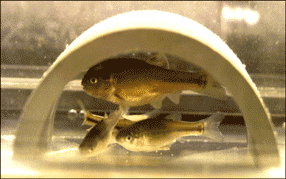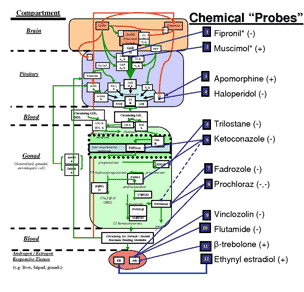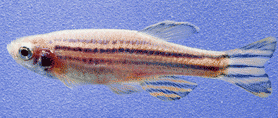A Systems-Based Approach to Link Exposure to Effects in Small Fish Models
Project Summary

EPA is tasked with protecting human health and ecosystems from adverse effects of toxic chemicals. To achieve this mission in an efficient and cost effective manner there is a need to develop improved methods to predict chemical toxicity based on mode of action and to extrapolate across chemical classes, across species, and for mixtures of chemicals, in a scientifically-sound manner that supports quantitative risk assessment. Our research using systems biology-based approaches to link chemical exposure to adverse effects in small fish models is aimed at addressing this need. Endocrine active chemicals known to act on different biochemical targets within the fish reproductive system are being systematically studied in a multi-phased approach. The series of biological responses ranging from early changes in gene expression and metabolite profiles, to cellular damage and organ dysfunction or adaptation, and ultimately to impacts on individual health and population viability are examined using both traditional hypothesis-based approaches as well as discovery-driven methods that take advantage of new (genomic) technologies to examine thousands of different biological responses simultaneously. Knowledge generated over the course of these experiments is being used to identify general principles that govern biological responses to chemical stressors and develop computer-based models that can be used to simulate or predict those responses. These principles and models should provide a foundation for more robust use of predictive approaches in ecological risk assessments.


Key products
Berninger, J.P., D. Martinovic-Weigelt, D.L. Villeneuve, and G.T. Ankley. Pathway-based analysis of fish transcriptomics data across effluent gradients in Minnesota rivers. Midwest SETAC, Minneapolis, MN, March 20-21, 2012.
Villeneuve, D.L., N. Garcia-Reyero, D. Martinovic-Weigelt, Z. Li, K.H. Watanabe, E.F. Orlando, C.A. LaLone, S.W. Edwards, L.D. Burgoon, N.D. Denslow, E.J. Perkins, and G.T. Ankley. A graphical systems model and tissue-specific functional gene sets to aid transcriptomic analysis of chemical impacts on the female teleost reproductive axis. Mutation Research, Special Issue, in press.
Wang, R.-L., D. Bencic, A. Biales, D. Lattier, M. Kostich, D.L.Villeneuve, G.T. Ankley, J. Lazorchak, and G. Toth. 2008. DNA microarray-based ecotoxicological biomarker discovery in a small fish model species. Environmental Toxicology and Chemistry 27:664-675.
Wang, R.-L., A. Biales, D. Bencic, D. Lattier, M. Kostich, D.L.Villeneuve, G.T. Ankley, J. Lazorchak, and G. Toth. 2008. DNA microarray application in ecotoxicology: Experimental design, microarray scanning, and factors impacting transcriptional profiles in a small fish species. Environmental Toxicology and Chemistry 27:652-663.
Martinovic, D., L.S. Blake, E.J. Durhan, K.J. Greene, M.D. Kahl, K.M. Jensen, E.A. Makynen, D.L. Villeneuve, and G.T. Ankley. 2008. Reproductive toxicity of vinclozolin in the fathead minnow: Confirming an anti-androgenic mode of action. Environmental Toxicology and Chemistry 27:478-488.
Ankley, G.T., K.M. Jensen, M.D. Kahl, E.A. Makynen, L.S. Blake, K.J. Greene, R.D. Johnson, and D.L. Villeneuve. 2007. Ketoconazole in the fathead minnow (Pimephales promelas) reproductive toxicity and biological compensation. Environmental Toxicology and Chemistry 26: 1214-1223.
Breen, M.S., D.L. Villeneuve, M. Breen, G.T. Ankley, and R.B. Conolly. 2007. Mechanistic computational model of ovarian steroidogenesis to predict biochemical responses to endocrine active compounds. Annals of Biomedical Engineering 35:970-981.
Ekman, D.R., Q. Teng, K.M. Jensen, D. Martinovic, D.L. Villeneuve, G.T. Ankley, and T.W. Collette. 2007. NMR analysis of male fathead minnow urinary metabolites: a potential approach for studying impacts of chemical exposures. Aquatic Toxicology 85:104-112.
Villeneuve, D.L., G.T. Ankley, E.A. Makynen, L.S. Blake, K.J. Greene, E.B. Higley, J.L. Newsted, J.P. Giesy, and M. Hecker. 2007. Comparison of fathead minnow ovary explant and H295R cell-based steroidogenesis assays for identifying endocrine-active chemicals. Ecotoxicology and Environmental Safety 68:20-32.
Villeneuve, D.L., L.S. Blake, J.D. Brodin, K.J. Greene, I. Knoebl, A.L. Miracle, D. Martinovic, and G.T. Ankley. 2007. Transcription of key genes regulating gonadal steroidogenesis in control and ketoconazole- or vinclozolin-exposed fathead minnows. Toxicological Sciences 98: 395-407.
Villeneuve, D.L., P. Larkin, I. Knoebl, A.L. Miracle, M.D. Kahl, K.M. Jensen, E.A. Makynen, E.J. Durhan, B.C. Carter, N.D. Denslow, and G.T. Ankley. 2007. A graphical systems model to facilitate hypothesis-driven ecotoxicogenomics research on the teleost brain-pituitary-gonadal axis. Environmental Science & Technology 41:321-330.
Watanabe, K.H., K.M. Jensen, E.F. Orlando, and G.T. Ankley. 2007. What is normal? A characterization of the values and variability in reproductive endpoints of the fathead minnow, Pimephales promelas. Comparative Biochemistry and Physiology (Part C) 146:348-356.
Miller, D.H., K.M. Jensen, D.L. Villeneuve, M.D. Kahl, E.A. Makynen, E.J. Durhan, and G.T. Ankley. 2006. Linkage of biochemical responses to population level effects: a case study with vitellogenin in the fathead minnow. Environmental Toxicology and Chemistry 26:521-527.
Villeneuve, D.L., I. Knoebl, M.D. Kahl, K.M. Jensen, D.E. Hammermeister, K.J. Greene, L.S. Blake, and G.T. Ankley. 2006. Relationship between brain and ovary aromatase activity and isoform-specific aromatase mRNA expression in the fathead minnow (Pimephales promelas). Aquatic Toxicology 76:353-368.
Villeneuve, D.L., A.L. Miracle, K.M. Jensen, S.J. Degitz, M.D. Kahl, J.J. Korte, K.J. Greene, L.S. Blake, A. Linnum, and G.T. Ankley. 2006. Development of quantitative real-time PCR assays for fathead minnow (Pimephales promelas) gonadotropin β subunit mRNAs to support endocrine disruptor research. Comparative Biochemistry and Physiology (Part C)145:171-183.
Ankley, G.T., K.M. Jensen, E.J. Durhan, E.A. Makynen, B.C. Butterworth, M.D. Kahl, D.L. Villeneuve, A.L. Linnum, L.E. Gray, M. Cardon, and V.S. Wilson. 2005. Effects of two fungicides with multiple modes of action on reproductive endocrine function in the fathead minnow (Pimephales promelas). Toxicological Sciences 86:300-308.Project personnel
| Name | Phone | |
| Gerald T. Ankley | ankley.gerald@epa.gov | 218-529-5147 |
| Daniel L. Villeneuve | villeneuve.dan@epa.gov | 218-529-5217 |
| Kathleen M. Jensen | jensen.kathleen@epa.gov | 218-529-5177 |
Research project update date
February 21, 2012
![[logo] US EPA](../gif/logo_epaseal.gif)